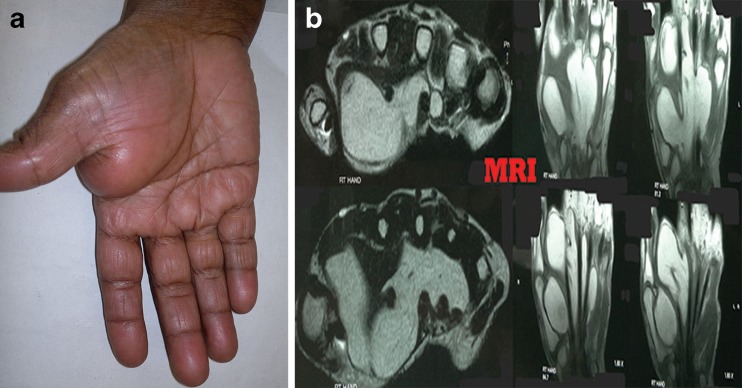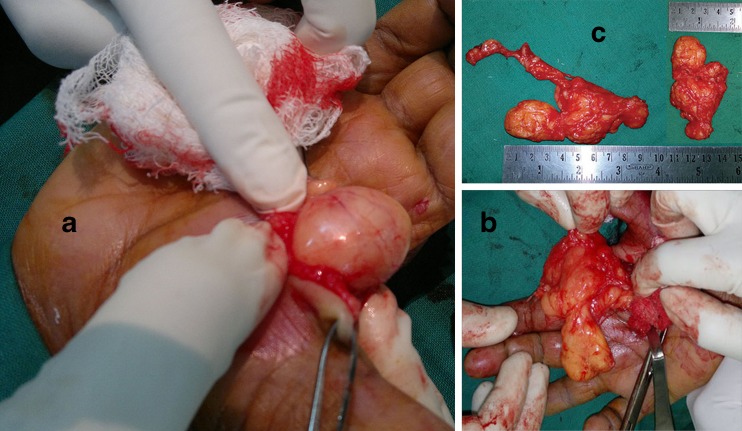Dear Sir,
Lipoma is the commonest soft-tissue tumor occurring almost in any part of the body [1]. A special subtype—‘giant lipoma’ merits mention as it accentuates the presenting symptoms and offers diagnostic dilemma regarding its benign nature to the surgeon. In this paper we present a case of a giant hand lipoma.
Sixty-one years old female presented with 4 × 4 cm swelling at her right thenar eminence since last 5 years (Fig. 1a). It was hindering her grasping activities so much so that she had to quit her job. Hand x-ray showed a diffuse soft-tissue shadow. Contrast-enhanced-magnetic-resonance-imaging showed 9.5 × 4.5 × 4cm homogeneous soft-tissue lump having superficial and deep components (Fig. 1b). It was masquerading further through 1st, 2nd till the 3rd web-spaces along the flexor digitorum tendons. Neuro-vascular structures were free. Hand-exploration through palmer-crease was performed to achieve its complete excision (Fig. 2a and b). She had a good postoperative recovery. Histopathology confirmed the benign nature of the lipoma.
Fig. 1.
a Thenar lipoma. Note its clinical extent. b MRI showing the complete extent of the giant lipoma. Note the coronal and the sagittal sections showing lipoma engulfing the tendons of flexor digitorum
Fig. 2.
Per-operative photograph showing initial part of lipoma projecting thru skin crease incision (a), followed by complete excision (b). c Completely resected specimen of giant lipoma. Note 9.5 × 4.5 × 4 cm size
It’s an interesting fact that hand lipomas are rare in spite of decent quantity of fat in palm region (1–3.8 %) [2]. Oster noted that the hand lipomas are peripherally positioned [2]. Their peripheral location may be due to thick mid-palmer fascia. They are unique in their presentation owing to limited palmer spaces (for their growth) surrounding important neuro-vascular structures. Mason further classified hand lipomas into superficial and deep palmar lipomas; the deeper ones are less common than the superficial ones and have complex variable morphology as noted in our patient [3]. Ones greater than 5 cm are designated as ‘giant’ lipomas and many of them have well-differentiated liposarcomatous components, which are difficult to differentiate from their benign counterparts [3, 4]. Patient usually approaches surgeon for compressive neurological symptoms, cosmesis, and fear of cancer (the 3 ‘C’s). Clinically small appearing hand lipomas may actually just be ‘a tip of ice-berg’ as found in our patient. Hence, they need a detailed imaging study by an MRI. Surgical excision remains the gold-standard for symptomatic and giant lipomas of the hand. Giant lipomas up to 8 cm have been reported in the literature [3, 4]. Our patient had 9.5 × 4.5 × 4 cm lipoma (Fig. 2c).
Considering the ‘intricate anatomy’ of hand, a high quality imaging is necessary for their detailed study. A meticulous margin-free resection is the key for good results.
Acknowledgments
Source of support
NIL
Conflict of interest
NONE
References
- 1.Pagonis T, Givissis P, Christodoulou A. Complications arising from a misdiagnosed giant lipoma of the hand and palm: a case report. J Med Case Rep. 2011;5(1):552. doi: 10.1186/1752-1947-5-552. [DOI] [PMC free article] [PubMed] [Google Scholar]
- 2.García Ceballos JI, Wylock P. Hand palm and finger lipomas: four case reports and review of the literature. Eur J Plast Surg. 2005;28:243–246. doi: 10.1007/s00238-005-0730-6. [DOI] [Google Scholar]
- 3.Inaparthy P, Southgate WG. Giant lipoma of hand: a case report. Eur J Orthop Surg Traumatol. 2006;16:251–252. doi: 10.1007/s00590-005-0062-z. [DOI] [Google Scholar]
- 4.Grivas TB, Psarakis SA, Kaspiris A, Liapi G, Giant Lipoma of the Thenar Case Study and Contemporary Approach to its Aetiopathogenicity. Hand (N Y) 2009;4(2):173–6. doi: 10.1007/s11552-008-9157-4. [DOI] [PMC free article] [PubMed] [Google Scholar]




